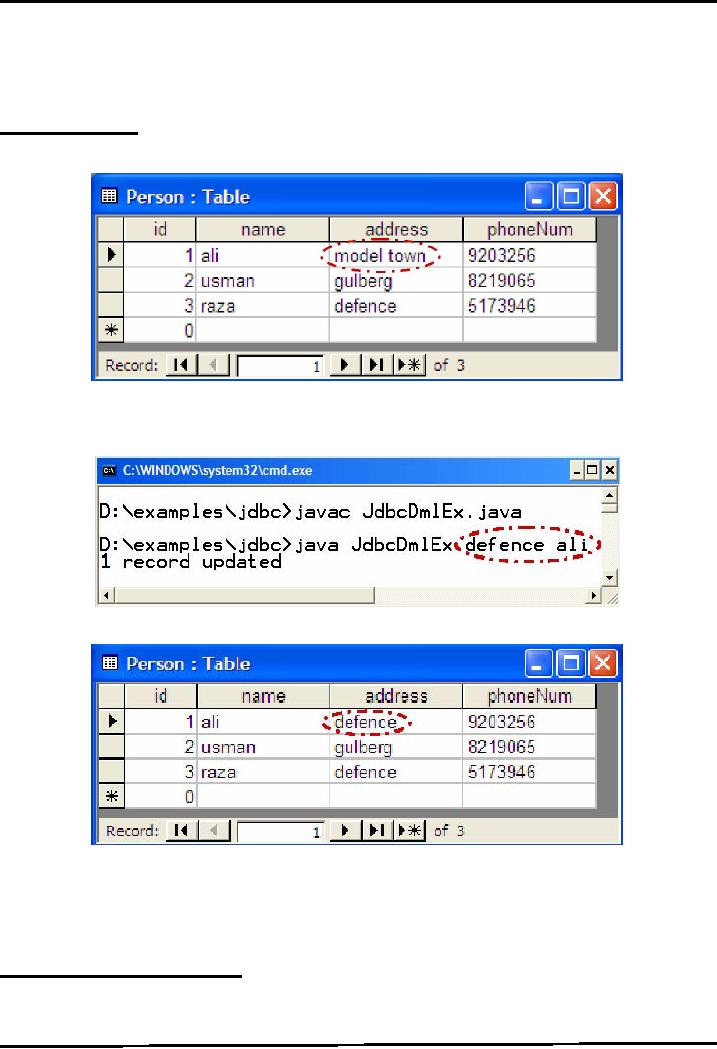 |
JAVA: More on JDBC |
| << Java Database Connectivity |
| JAVA: Result Set >> |

Web
Design & Development CS506
VU
Lesson
15
More on
JDBC
In the
previous handout, we have discussed
how to execute SQL
statements. In this handout,
we'll learn
how
to execute DML (insert, update, delete)
statements as well some
useful methods provided by the
JDBC
API.
Before
jumping on to example, lets take a
brief overview of executeUpdate()method
that is used for
executing
DML statements.
Useful
Statement Methods:
o executeUpdate(
)
. Used to
execute for INSERT, UPDATE,
or DELETE SQL
statements.
.
This method returns the number of rows that were
affected in the database.
Also
supports DDL (Data
Definition Language) statements
CREATE TABLE, DROP
..
TABLE,
and ALERT TABLE etc. For
example,
int
num = stmt.executeUpdate("DELETE from
Person WHERE id = 2" );
Example
Code 15.1: Executing SQL DML
Statements
This
program will take two
command line arguments that
are used to update records in the
database.
executeUpdate(
) method will be used to achieve the
purpose stated above.
//
File JdbcDmlEx.java
//step 1:
import packageimport java.sql.*;
public class
JdbcDmlEx
{public static void main
(String args[ ]) { try {
//Step 2:
load
driverClass.forName("sun.jdbc.odbc.JdbcOdbcDriver");
//Step
3: define the connection
URL
String
url = "jdbc:odbc:personDSN";
//Step
4: establish the connection
Connection
con =
DriverManager.getConnection(url);
//Step 5:
create Statement
Statement
st = con.createStatement();
// assigning
first command line argument
value
String
addVar = args[0];
// assigning
second command line argument
value
String
nameVar = args[1];
//
preparing query nameVar &
addVar strings are
embedded
//
into query within `" + string +
"'
String
sql = "UPDATE Person SET
address = `"+addVar+"'" +
" WHERE
name = `"+nameVar+"' ";
//
executing query
int
num = st.executeUpdate(sql);
//
Step 7: process the results of the
query
//
printing number of records
affected
System.out.println(num
+ " records updated");
//Step
8: close the connection
con.close();
120

Web
Design & Development CS506
VU
}catch(Exception
sqlEx){
System.out.println(sqlEx);
}
} // end
main} // end class
Compile
& Execute
The
Person table is shown in the following
diagram before execution of the
program. We want to update
first
row i.e address of the
person ali.
The
next diagram shows how we
have executed our program. We passed it
two arguments. The first one
is
the
address (defence) and later one is the
name (ali) of the person against
whom we want to update the
address
value.
The
Person table is shown in the following
diagram after the execution of the
program. Notice that
address
of the
ali is now changed to
defence.
Note
When
we execute DML statements (insert, update,
delete) we have to commit it in the
database explicitly to
make the
changes permanent or otherwise we can
rollback the previously executed
statements.
But
in the above code, you have never
seen such a statement. This
is due to the fact that java
will implicitly
commit
the changes. However, we can
change this java behavior to
manual commit. We will cover
these in
some
later handout.
Useful
Statement Methods (cont.):
o
getMaxRows /
setMaxRows(int)
.
Used
for determines the number of rows a ResultSet may
contain
.
By
default, the number of rows are unlimited
(return value is 0), or by
using
121

Web
Design & Development CS506
VU
setMaxRows(int),
the number of rows can be
specified.
o
getQueryTimeOut
/ setQueryTimeOut (int)
.
Retrieves the
number of seconds the driver will
wait for a Statement object
to execute.
.
The
current query time out
limit in seconds, zero means
there is no limit
.
If the
limit is exceeded, a SQLException is
thrown
Different
Types of Statements
.
As we have
discussed in the previous handout
that through Statement objects,
SQL queries
are
sent to the databases.
.
Three
types of Statement objects are available.
These are;
1.
Statement
-The
Statement objects are used
for executing simple SQL
statements. -We have
already
seen
its usage in the code
examples.
2.
PreparedStatement
-The
PrepaeredStatement are used
for executing precompiled
SQL statements and passing
in
different
parameters to it.
- We
will talk about it in detail
shortly.
3.
CallableStatement
-
Theses are used for
executing stored
procedures.
-We
are not covering this
topic; See the Java tutorial
on it if you are interested in learning
it.
Prepared
Statements
What
if we want to execute same
query multiple times by only
changing parameters.
PreparedStatement
object differs from
Statement object as that it is
used to create a statement
in
standard
form that is sent to
database for compilation,
before actually being
used.
Each
time you use it,
you simply replace some of the marked
parameters (?) using some
setter
methods.
We
can create PreparedStatement
object by using prepareStatementmethod of the
connection class.
The
SQL query is passed to this
method as an argument as shown below.
PreparedStatement
pStmt = con.prepareStatement ("UPDATE tableName
SET columnName = ? " +
"WHERE
columnName = ? " );
Notices
that we used marked parameters
(?)
in
query. We will replace them later on by
using
various
setter methods.
If we
want to replace first ? with
String value, we use setString method and
to replace second ?
with
int value, we use setInt
method. This is shown in the following
code snippet.
pStmt.setString (1
, stringValue);
pStmt.setInt
(2 , intValue)
Note:
The
first market parameter has
index 1.
.
Next,
we can call executeUpdate (for
INSERT, UPDATE or DELETE queries) or
executeQuery (for
simple
SELECT query) method.
pStmt.executeUpdate();
Modify
Example Code 15.1: Executing
SQL DML using Prepared
Statements
This
example code is modification to the last
example code (JdbcDmlEx.java).The
modifications are
highlighted
as bold face.
//
File JdbcDmlEx.java
//step 1:
import packageimport
java.sql.*;
public
class JdbcDmlEx {public static
void main (String
args[ ]) {
try {
//Step 2:
load
driverClass.forName("sun.jdbc.odbc.JdbcOdbcDriver");
//Step
3: define the connection
URL
122

Web
Design & Development CS506
VU
String
url = "jdbc:odbc:personDSN";
//Step
4: establish the
connection
Connection
con = DriverManager.getConnection(url, "",
"");
//
make query and place ? where values
are to
//be
inserted later
String
sql =
"UPDATE
Person SET address = ? " + "
WHERE name = ?
";
//
creating statement using
Connection object and passing //
sql statement as
parameter
PreparedStatement
pStmt = con.prepareStatement(sql);
// assigning
first command line argument
valueString addVar =
args[0];
// assigning
second command line argument
valueString nameVar = args[1];
//
setting
first marked parameter (?) by
using setString()// method to
address.
pStmt.setString(1 ,
addVar);
//
setting second marked parameter(?) by
using setString()// method to
name
pStmt.setString(2 ,
nameVar);
//
suppose address is "defence" &
name is "ali"
// by
setting both marked parameters,
the query will
look
//
like:
// sql =
"UPDATE Person SET address =
"defence"
//
WHERE name = "ali" "
//
executing update statemnt
int
num = pStmt.executeUpdate();
//
Step 7: process the results of the
query// printing number of
records
affectedSystem.out.println(num
+ " records updated");
//Step
8: close the connection
con.close();
}catch(Exception
sqlEx){
System.out.println(sqlEx);
}
} // end
main} // end class
Compile
& Execute
Execute
this code in a similar way
as we showed you in execution of the last
program. Don't forget to
pass
the
address & name values as the command
line arguments.
References:
Entire
material for this handout is
taken from the book JAVA A
Lab Course by Umair
Javed.
This
material
is available just for the
use of VU students of the course Web
Design and Development and not
for
any
other commercial purpose without the
consent of author.
123
Table of Contents:
- JAVA FEATURES
- Java Virtual Machine & Runtime Environment
- Learning Basics of JAVA
- JAVA: Object Oriented Programming
- JAVA: Inheritance
- JAVA: Collections
- JAVA: Intro to Exceptions
- JAVA: Streams
- JAVA: Modification of Address Book Code
- JAVA: Graphical User Interfaces
- JAVA: Event Handling
- JAVA: More Examples of Handling Events
- JAVA: Problem in Last Code Example
- Java Database Connectivity
- JAVA: More on JDBC
- JAVA: Result Set
- JAVA: Meta Data
- Java Graphics
- JAVA: How to Animate
- JAVA Applets
- JAVA: Socket Programming
- JAVA: Serialization
- JAVA: Multithreading 1
- JAVA: Multithreading 2
- JAVA Web Application Development
- Java Servlets
- JAVA: Creating a Simple Web Application in Tomcat
- JAVA: Servlets Lifecycle
- JAVA: More on Servlets
- JAVA: Dispatching Requests
- JAVA: Session Tracking 1
- JAVA: Session Tracking 2
- JAVA: AddressBook Case Study Using Sevlets
- Java Server Pages 1
- JavaServer Pages 2
- Java Server Pages 3
- JAVA: JSP Action Elements and Scope
- JAVA: JSP Custom Tags
- JAVA: MVC + Case Study
- JAVA: MVC Model 2 Architecture
- JAVA: Layers and Tiers
- JAVA: Expression Language
- JAVA: JavaServer Pages Standard Tag Library (JSTL)
- JAVA: Client Side Validation & JavaServer Faces (JSF)
- JAVA: JavaServer Faces